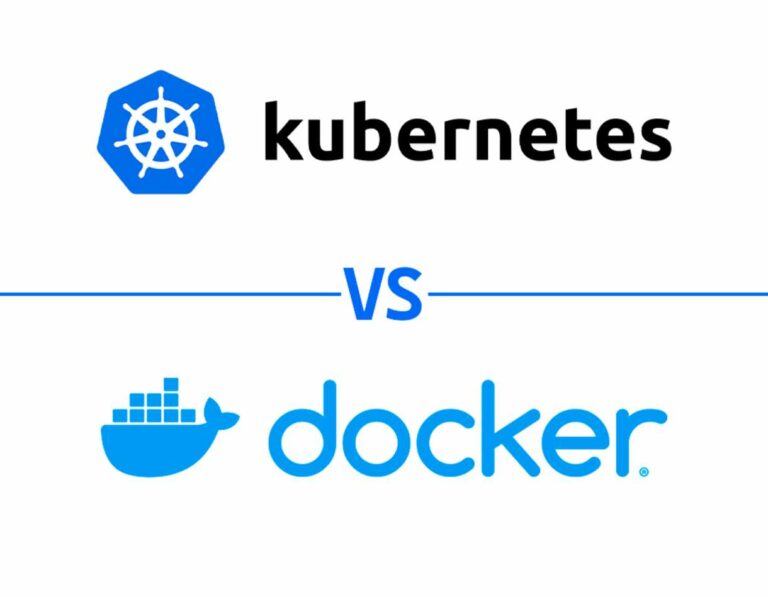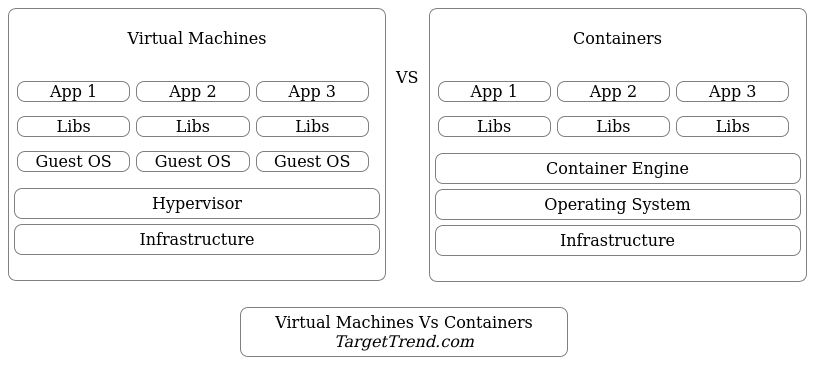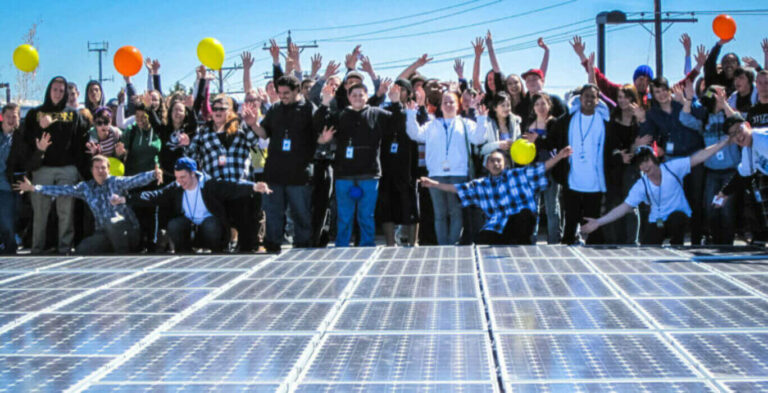Kubernetes Vs Docker: A Thorough Comparison
Are you exploring containerization but can't seem to choose between Kubernetes and Docker? Delve into this blog to discover their similarities, their differences, and what your application needs.

Kubernetes and Docker are two cloud-native technologies with similar functionality but very different purposes.
They are both used in managing containers but that’s where their similarities end. Docker is ideal for everyday use in creating, running, and managing containerized applications, while Kubernetes is more for managing a large cluster of containerized apps.
Both tools come with their pros and cons, so it’s important to know what each does best and when or not to use it. This blog post sheds light on this issue to help you choose right.
Virtual Machines Vs Docker Vs Kubernetes
Docker and Kubernetes are both containerization technologies. A container can be created on either a physical or virtual machine. A virtual machine is a digital copy of a physical machine that you can run on any virtual machine host.
To get access to compute resources in the cloud, you typically need to rent a VM (virtual machine) from your cloud service provider. Then you can install containerization applications like Docker into it if you need to. So, cloud-service providers often include pre-installed container images in their VM instances.
A virtual machine provides a secure and isolated environment to execute your code in. You can develop your application on the virtual machine, then save and transfer it to run on any other VM host with ease. However, there are a few issues with this process.
First, being a copy of an operating system, a VM copy can be quite large, often reaching Gigabytes in size. This also makes it slow to start, often extending to a few minutes, which can present issues in time-critical situations.
Containerization solves this problem by creating a relatively lightweight execution environment that is only Megabytes in size and can start in just a few seconds or fractions thereof anywhere and at any time. Additionally, having lightweight containers has led to the breakdown of large, monolithic websites into smaller, easier-to-manage, and scalable parts, now referred to as micro-services.
The two most popular of these containerization technologies are Docker and Kubernetes. Docker helps developers to build, deploy, and manage their containers in the cloud, while Kubernetes helps to manage complex projects with dozens or even hundreds of micro-services.

What Is Docker?
Docker is an open-source containerization platform that offers a lightweight approach to developing and deploying applications anywhere. Docker enables developers to automate the packaging, deployment, and execution of their applications within a defined container in any environment.
The Docker system consists of many components, including the Docker daemon and the Docker client, as well as the Docker Hub that hosts different Docker images. This Docker image is a standalone package declared in a Dockerfile and it contains everything needed to run the application, from code to libraries, system tools, and dependencies.
Docker makes it easy to do all this and get your application working smoothly on any platform, and that is why it is a popular containerization system.
Pros & Cons of Docker
As with every technology, Docker comes with its pros and cons based on its design. The following are the important ones to be aware of.
Pros
- Simplicity: Docker is designed for ease of use. It keeps things simple with straightforward commands and an intuitive design that makes it easy for even beginners to build, package, distribute, and execute code on Docker containers.
- Lightweight: Docker images are as lightweight as possible, with some as little as 5MB. This makes them quick to deploy and manage. Plus, they use fewer resources and are optimized overall for minimal infrastructure costs.
- Versatile & Portable: You can run a Docker application across as many platforms and environments as you like. Docker is designed this way, so that all you need is the right Docker image to execute your application, irrespective of the underlying operating system from macOS to Linux or Windows.
- Large Image Repository: The Docker Hub image repository packs over 100k container images from individual developers, open-source projects, and software vendors that can be easily downloaded and deployed anywhere.
Cons
- Single Node Design: Docker is primarily designed around a single node. Containers on this single node can connect, but connectivity or container management outside the node is not possible. Docker Swarm, however, makes it easy to manage multiple nodes at once.
- Limited Orchestration: You can create, deploy and manage containers easily with Docker. But compared to Kubernetes, you will be relatively limited when it comes to automation features such as cluster networking, service discovery, auto-scaling, self-healing, and so on.
What Is Kubernetes?
Kubernetes is also an open-source project, a container orchestration system designed to automate as many processes as possible – from the deployment of containers to their management, scaling, and load balancing. It is a robust platform for maintaining highly complex containerized applications.
The Kubernetes architecture is cluster-based – that is, it manages multiple computing infrastructure nodes as though they were one system. This allows an admin to add as many nodes to the cluster, as necessary and manage them all from a single master node.
A Kubernetes cluster requires you to initially define a desired application state, and then it will work to maintain it using automatic scaling, self-healing, load balancing, and service discovery.
Pros & Cons of Kubernetes
Kubernetes equally comes with its advantages and disadvantages based on its technical design and intended purpose. Here are the major ones.
Pros
- Scalability: Kubernetes is designed for complex applications at scale. If you need to manage hundreds or more micro-services at peak usage with as little manual work as possible, then Kubernetes is the platform for you. It automatically handles your scaling needs.
- High Availability: The platform comes with many advanced features, including self-healing and load-balancing to seamlessly manage your applications, restart crashed containers, and minimize downtime.
- Management & Orchestration: Kubernetes also offers everything you need to get even the most complex setups working in harmony. From networking to storage, deployment, and rolling updates, all the features you will ever need are there.
- Big Community: The Kubernetes project was started by Google and is equally backed by many other tech giants. It offers a rich and vibrant open-source ecosystem for interested developers.
Cons
- Resource Overhead: Kubernetes is designed for managing large computer clusters. So, its first downside is the big investment needed to either acquire or maintain such huge infrastructure and computing resources.
- Steep Learning Curve: The system is complex due to its robust design and vast feature set. You will need a deep understanding of containers and related technologies to get a Kubernetes project moving.
Side By Side Comparison Kubernetes and Docker
Here is a side-by-side comparison of the Kubernetes and Docker platforms.
| Features | Docker | Kubernetes |
|---|---|---|
| Purpose | Package apps into runtime environments | Co-ordinating multiple containers across multiple servers |
| Containerization | Includes container creation, deployment & management features | Supports many container systems |
| Availability | Limited | Highly available |
| Scalability | Manual | Automatic |
| Orchestration | Available with Docker Swarm | Highly flexible |
| Performance | High | High |
| Load Balancing | Limited | Extensive |
| Resource Requirements | Low | High |
| Learning Curve | Low | High |
| Self Healing | N/A | Yes |
| Community | Open-source & Enterprise editions | Free & Open-source |
- Purpose: Both tools were created for entirely different reasons. Docker excels at creating and managing containerized applications, while Kubernetes excels at managing large-scale containerized applications. Docker Swarm is an extra package that offers many of Kubernetes’ features but is less complex.
- Containerization: Docker includes a suite of tools to create, deploy, and manage your containerized applications. Kubernetes offers no such tools. However, it relies on 3rd-party container technologies to work, including Docker engine, containerd, and CRI-O.
- Availability: Kubernetes is the number #1 platform for those looking to build a large and highly available cloud application.
- Scalability: Docker containers are not automatically scalable by default and the same goes for Docker Swarm clusters. You will have to manually scale the systems. On the other hand, Kubernetes auto-scales with a minimum required configuration set by the admin.
- Orchestration: You can create and connect many services on a single host using Docker, but you can’t do that across hosts. Docker Swarm and Kubernetes, however, can work across multiple hosts.
- Performance: If you are building a product or simply hosting a small application, then Docker might be your best option. If you want to try your hand at something large and more complex, then Docker Swarm might be a good introduction to production-grade cloud orchestration. Beyond that, only Kubernetes can deliver.
- Resource Requirements: Docker has a relatively low resource requirement compared to Kubernetes.
- Learning Curve: Both Docker and Docker Swarm are much easier to learn and understand than Kubernetes.
- Self Healing: Kubernetes includes self-healing (monitoring & restarting) of crashed applications straight out of the box.
- Community: Docker has a vibrant online community with the Docker Hub for sharing and finding container images. Kubernetes equally has a fledging community with many big tech names from Google to Shopify, Udemy, and more.
Frequently Asked Questions
People ask a lot of questions about the relationship between Kubernetes and Docker. And while not a full list, the following are some of the frequently asked questions.
Which is better, Docker or Kubernetes?
It depends on the task at hand. Choose Docker for simple applications. Choose Kubernetes for complex applications.
Which tool offers higher scalability, Docker or Kubernetes?
Kubernetes offers much higher scalability with helpful features than Docker or Docker Swarm.
Will Docker replace Kubernetes for container orchestration?
No, Docker cannot fully replace Kubernetes when it comes to advanced container orchestration. Docker Swarm can give you many of Kubernetes’ functionality, however, but not all.
Does Kubernetes have an image repository?
No, Kubernetes does not have an image repository because it uses images from other containerization systems, such as Docker and CRI-O.
Can Kubernetes and Docker be used together?
Yes, you can use Docker as the container engine in your Kubernetes setup.
Does Kubernetes require Docker to work?
No, Kubernetes can work with a variety of containerization engines, including Docker Engine, CRI-O, and containerd.
Conclusion
The containerization battle between Docker and Kubernetes is one that many developers often face with their cloud-native applications. Both are production-grade platforms and equally capable in their respective tasks.
Docker’s simplicity, portability, and user-friendliness make it ideal for small teams, individual developers, and limited-budget projects. Kubernetes, on the other hand, excels in complex environments with its rich set of tools that makes it the ideal solution for large teams and big-budget projects.
As you must see by now, which of these two containerization tools you should choose, depends on your project.





